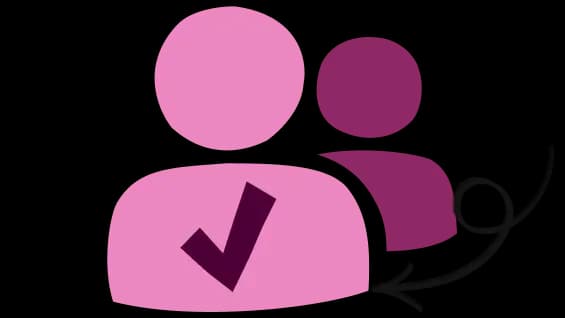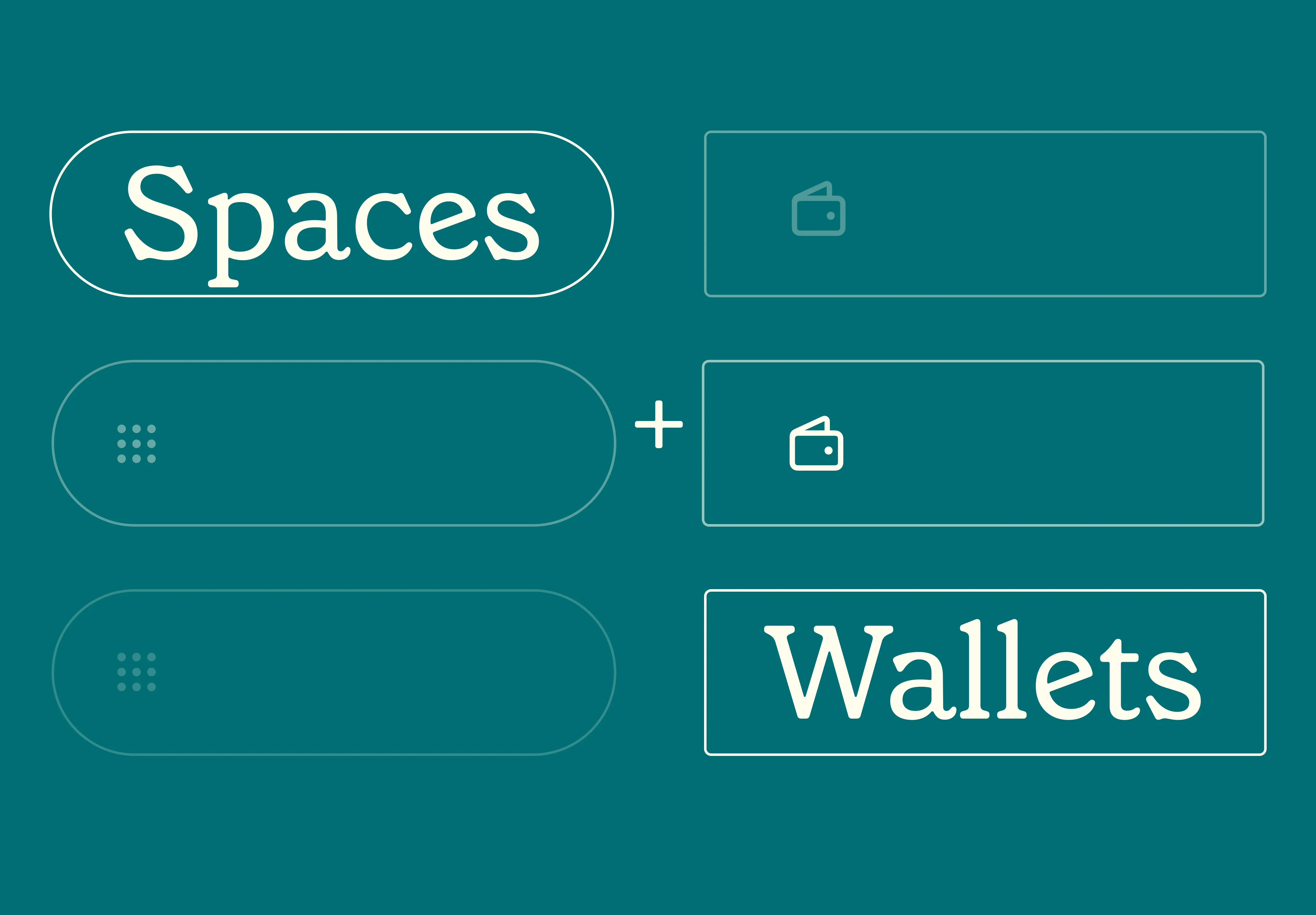14 Nov 2025
|14 min
Persona research: Research process, tips & more
Learn how to develop accurate user personas with our guide. Explore research processes, practical tips, and best practices for effective persona development.

Great design doesn’t happen in a vacuum. It starts with understanding the people you’re designing for – their goals, challenges, and motivations.
Persona research offers a way forward.
It transforms abstract ideas about your audience into clear, relatable stories that guide design decisions and help you focus on what matters most to your users.
In this guide, we’ll walk you through creating personas step by step – from gathering insights to avoiding common pitfalls – so you can design products that solve real problems and build lasting connections with your audience.
Key takeaways
What are personas? Fictional, research-based profiles that represent audience segments.
Steps to build personas: Define goals, gather and analyze data, segment your audience, create profiles, validate with user feedback, and align them with your strategy.
Avoid these mistakes: Don’t guess without data, overload profiles, create too many personas, or fail to share them internally.
Keep them fresh: Regularly test and update your personas to reflect audience and market changes.
Use research tools: Tools like Lyssna, SurveyMonkey, and Semrush make persona creation easier.
Start building better personas
Create research-backed user personas using our free template.
What are personas and why do they matter?
User personas are fictional, research-based profiles that represent real segments of your audience. They help you see beyond the data and into the lives of the people you’re designing for.
A great persona isn’t just a bullet-point list of demographics; it’s a story. It’s a way to understand what your audience dreams of, struggles with, and values most.
Why does this matter? Because without personas, you’re stuck designing for “everyone.” And when you try to please everyone, you usually end up pleasing no one.
Personas keep your focus sharp and your solutions impactful.

Persona research process
Think of the process as a journey: you’re not just collecting data; you’re uncovering the story behind your users. Here’s how to do it step by step.
1. Define your objectives
Before diving in, get clear on why you’re creating personas. Are you refining your product? Improving your marketing? Clarifying your user journey? A clear purpose ensures your personas are relevant and actionable.
2. Collect data
Data is the backbone of good personas. Combine quantitative data – like analytics and surveys – with qualitative insights from user interviews and focus groups, and other qualitative research types. If you’re new to gathering this kind of data, exploring different types of quantitative analysis such as a quantitative usability study, can help you choose the best approach for your research. What tasks do users struggle with? What tools do they love? The richer your data, the more useful your personas will be.
3. Analyze and identify patterns
Once you’ve gathered your data, start looking for patterns. Do certain pain points keep surfacing? Are there shared goals among different users? This is where you start to see your audience as distinct groups, each with their own needs and behaviors.
4. Segment your audience
Group users into meaningful segments based on the patterns you’ve identified. Each segment should feel like a distinct persona – a unique slice of your audience with its own story to tell.
5. Develop persona profiles
Now, bring those segments to life. Give them names, challenges, goals, and context. This is where raw data transforms into a relatable character your team can empathize with and design for.
6. Validate your personas
Don’t stop at creation. Share your personas with your team, and where possible, get feedback from real users. Validating your personas keeps them accurate and aligned with your audience.
7. Integrate personas into your strategy
Of course, personas only add value when you actively use them! Whether informing product features, guiding marketing campaigns, or shaping customer experiences, make sure your personas are woven into your decision-making process.
Solid research transforms personas from vague guesses into tools that help your team design with users in mind. And that shift changes everything.
Our top 5 tips for conducting persona research
When it comes to persona research, the right approach makes all the difference. These five tips will make sure your process is insightful, thorough, and practical.
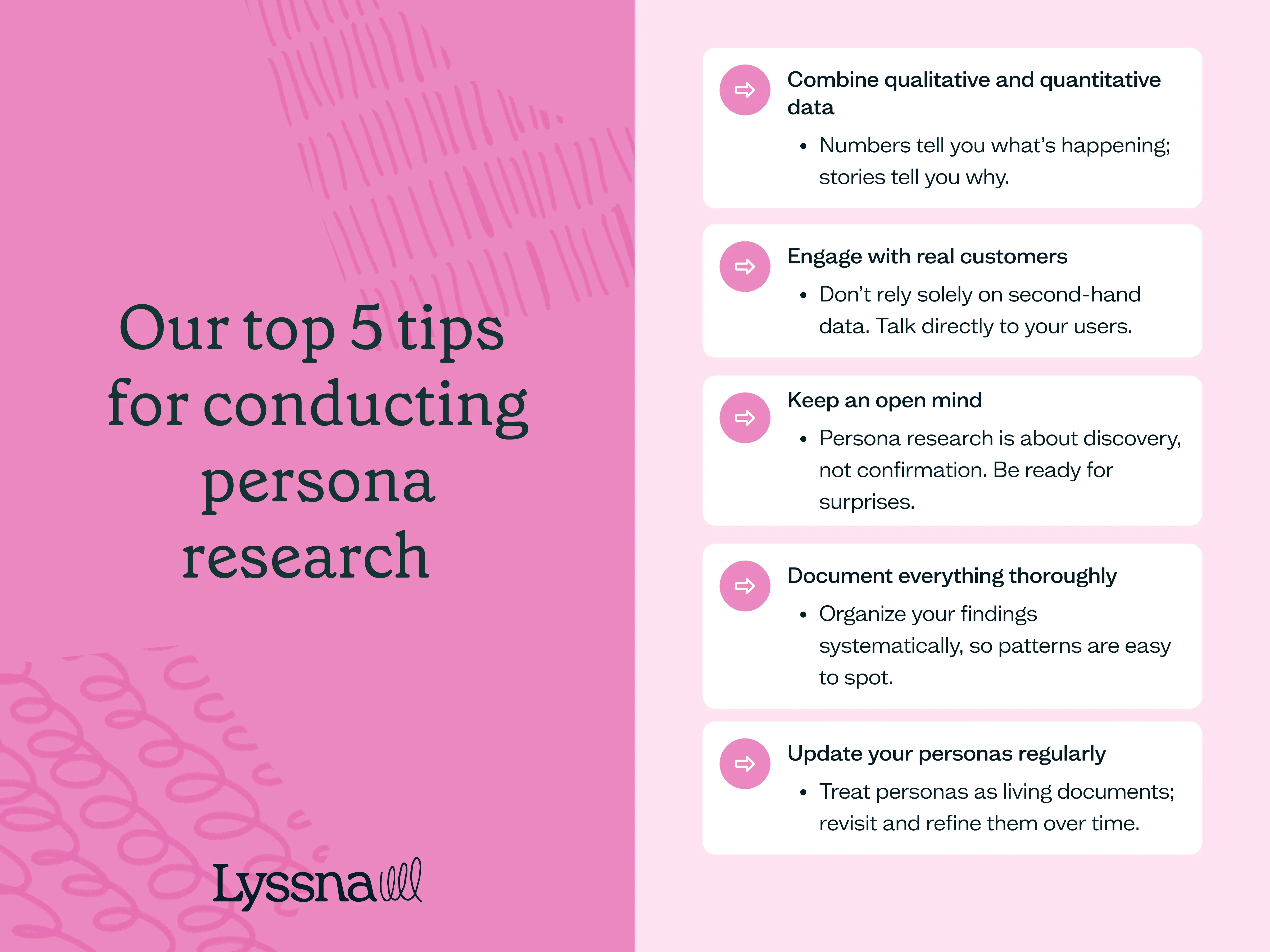
1. Combine qualitative and quantitative data
Numbers tell you what’s happening; stories tell you why. For instance, analytics might highlight a high drop-off rate at a particular stage in your app, but user interviews can uncover that a specific persona finds the navigation confusing.
This helps you understand the underlying reasons behind the behavior, allowing you to refine your personas and make targeted design improvements.
2. Engage with real customers
Don’t rely solely on second-hand data. Talking directly to users – through interviews, surveys, or usability testing – gives you an idea about their goals, frustrations, and experiences. Real voices lead to authentic personas.
3. Keep an open mind
Persona research is about discovery, not confirmation. Be ready for surprises – like learning that users value ease of use more than those slick, cutting-edge features you’ve prioritized.
4. Document everything thoroughly
Organize your findings systematically, so patterns are easy to spot. Clear documentation stored in a ux research repository also helps your team revisit the findings whenever they need to.
5. Update your personas regularly
As Anatoli Ivashnyenko, Head of Product at Sitly, shares: “Treat personas as living documents; revisit and refine them as you gather more user insights, ensuring they remain aligned with evolving user expectations and market dynamics.”
Common mistakes in persona research
Even with the best intentions, it’s easy to fall into traps that can undermine your persona research. Avoiding these common mistakes will ensure your personas are accurate, actionable, and valuable to your team.
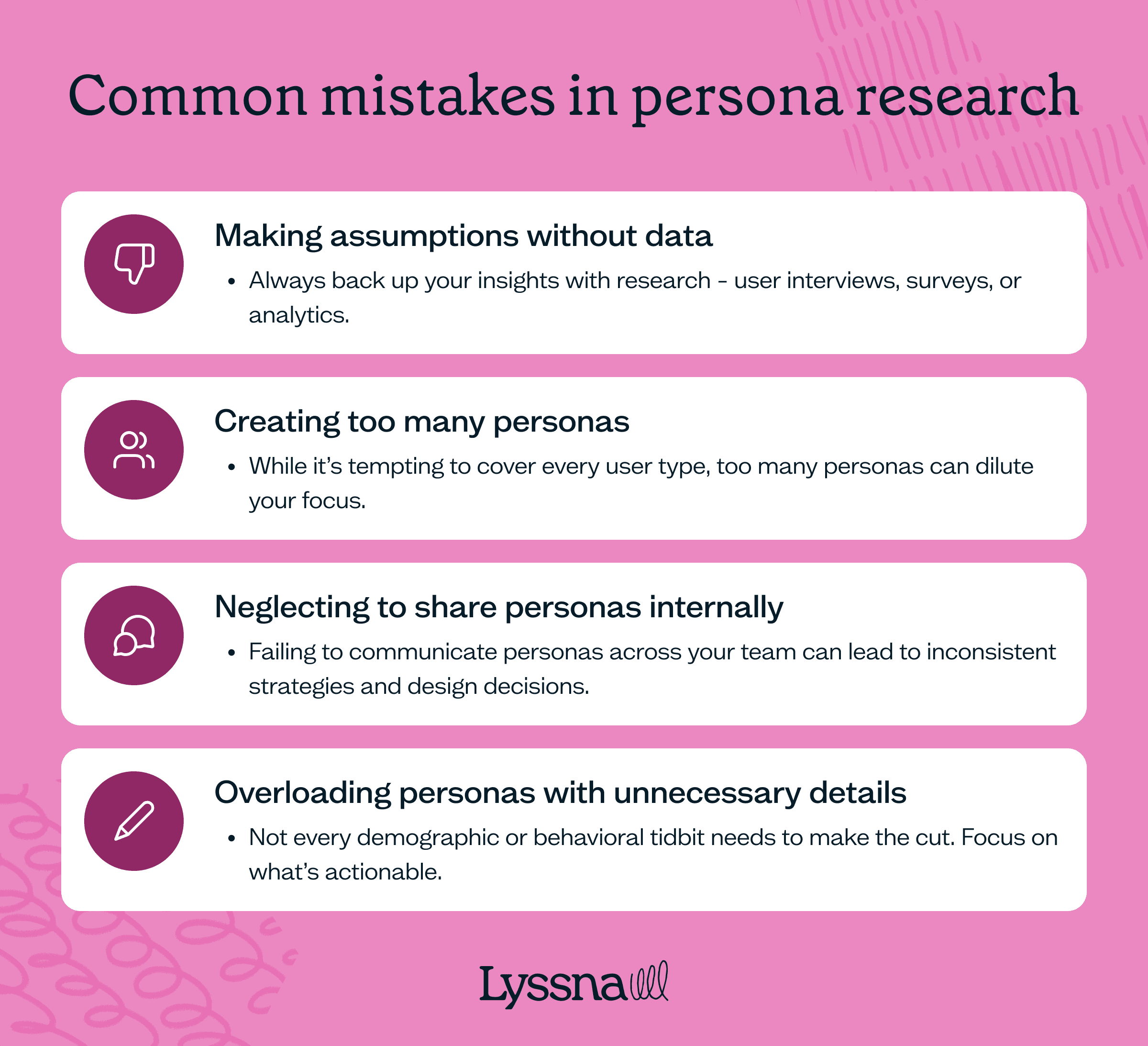
Making assumptions without data
Save your educated guesses for bar trivia! Always back up your insights with research – such as clippings from user interviews, quotes from surveys, or quantitative data.
Ernest Owusu, Leader at 6Sense, says, “this is huge. Often times we make assumptions based upon how our products help our personas without actually gathering feedback from them. Quick gut check. Task yourself to spend 60 seconds explaining what your personas do day in and day out and have the talk track be completely unrelated to your product. If you can do this, you know your personas. If you can’t, your definitions are based upon ill informed assumptions.”
Creating too many personas
While it’s tempting to cover every user type, too many personas can dilute your focus. Instead, prioritize the segments that matter most. Aim for a manageable number of personas representing your core audience and their key behaviors.
Neglecting to share personas internally
Failing to communicate personas across your team can lead to inconsistent strategies and design decisions. Make sure they’re accessible, understood, and integrated into every relevant workflow.
Overloading personas with unnecessary details
Not every demographic or behavioral tidbit needs to make the cut. Focus on what’s actionable. If it doesn’t help your team design better, leave it out.
How to validate and update personas
Creating personas is just the beginning. To keep them relevant and actionable, you need to validate them regularly and update them as your audience (or market) evolves. Here’s how.
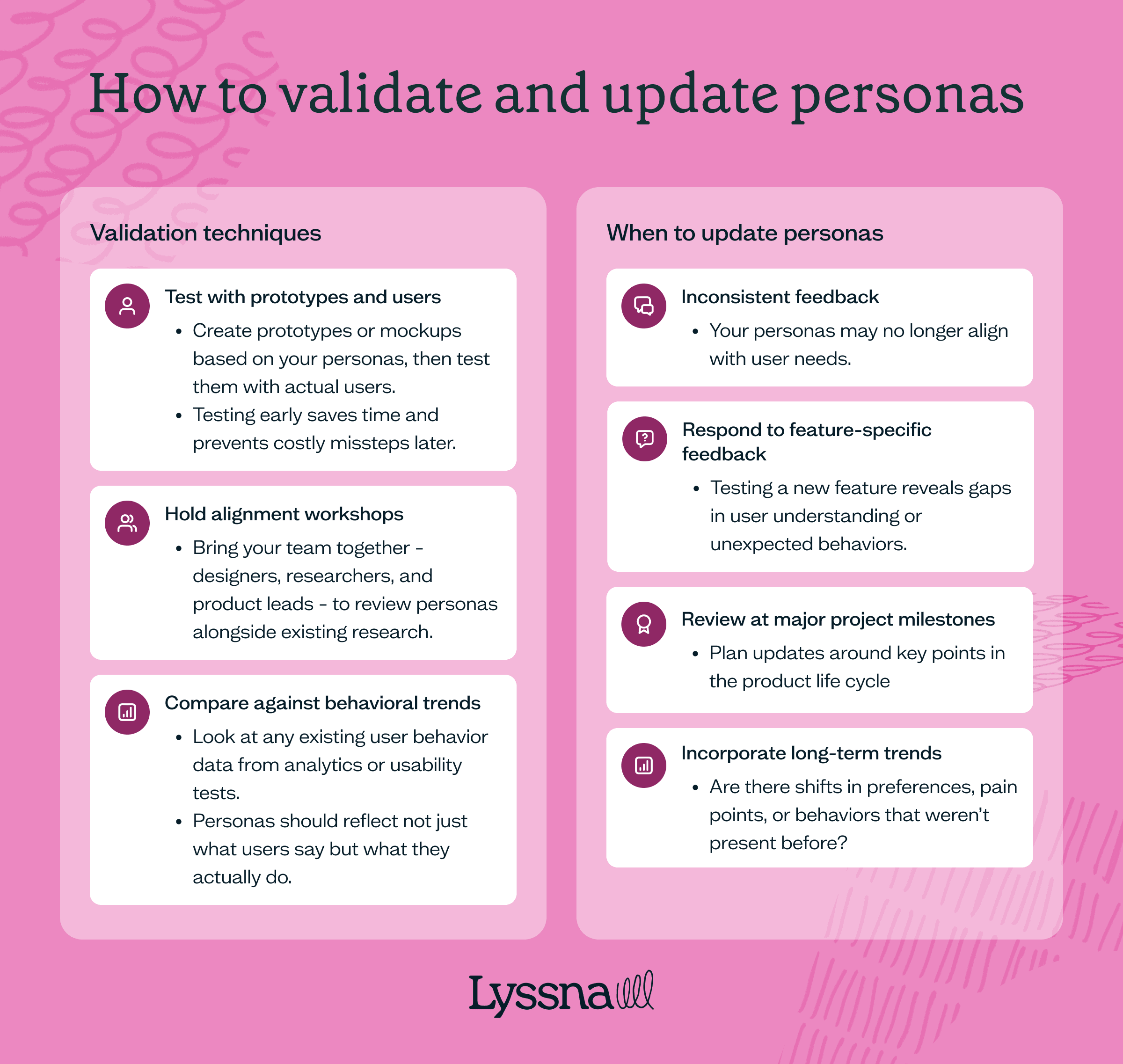
Validation techniques
Test personas against reality: A persona is only valuable if it accurately represents your real users. Validate your personas by first creating prototypes that address the needs and pain points identified in your personas. Then test these prototypes with real users who match your persona profiles. If real users face different challenges or behave differently than your personas predicted, revise your personas accordingly. Early validation helps prevent building the wrong solutions based on inaccurate assumptions.
Hold alignment workshops: Bring your team together – designers, researchers, and product leads – to review personas alongside existing research. Does everything match up? Are the personas clear and reflective of what you’ve learned? These workshops aren’t just about critique, they’re about collaboration and sharpening your personas.
Compare against behavioral trends: Look at any existing user behavior data. If a persona prioritizes speed but the data shows users often pause to read instructions, it’s a signal to dig deeper. Personas should reflect not just what users say but what they actually do.
When and how to update personas
Review when feedback is inconsistent: Seeing inconsistent feedback from testing? This could be a red flag that your personas no longer align with user needs. Use these moments as a prompt to revisit and refine.
Update based on feature testing: If testing a new feature reveals gaps in user understanding or unexpected behaviors, it’s another sign your personas might need to be updated.
Schedule reviews at milestones: Plan updates around key points in the ux product life cycle – before significant product iteration or at the start of new projects. This makes sure the personas guiding your decisions remain relevant and accurate.
Track long-term trends: Look at patterns from aggregated user data over time. Are there shifts in preferences, pain points, or behaviors that weren’t present before? Use these trends to fine-tune personas and better anticipate future needs.
Examples of effective personas
Well-crafted personas bring your users to life. They’re more than data points – they’re stories that guide your decisions. Below, we’ll explore two fictional products, each with personas that show how targeted research drives better design decisions.
Product 1: A remote work productivity app
“Digital Nomad Daniel”
Demographics:
Age: 30
Occupation: Freelance Graphic Designer
Location: Travels frequently, currently in Bali
Goals:
Find reliable remote work opportunities.
Stay organized across projects despite changing time zones.
Challenges:
Inconsistent internet access affects work.
Difficulty maintaining focus with no structured work environment.
Behaviors:
Uses coworking apps to find local workspaces.
Relies on digital tools to manage tasks and deadlines.
“Team Leader Tara”
Demographics:
Age: 38
Occupation: Project Manager
Location: Based in New York, managing a distributed team
Goals:
Foster team collaboration across time zones.
Ensure everyone stays aligned on deadlines and deliverables.
Challenges:
Tracking team progress when schedules overlap minimally.
Communicating effectively with remote employees who have different working styles.
Behaviors:
Regularly hosts virtual meetings.
Evaluates tools for seamless communication and project tracking.
Persona connection: For a remote work productivity app, Daniel, a digital nomad, might prioritize offline capabilities, while Tara, a team leader, values robust dashboards for managing her team.
Product 2: A personalized wellness platform
“Health-conscious Hannah”
Demographics:
Age: 42
Occupation: Accountant
Location: Lives in a metropolitan city
Goals:
Maintain a healthy lifestyle while balancing a busy work schedule.
Access evidence-based information on fitness and nutrition.
Challenges:
Limited time for exercise or meal preparation.
Overwhelmed by conflicting advice in health forums.
Behaviors:
Uses fitness-tracking apps.
Frequently searches for healthy meal delivery options.
“Active Adam”
Demographics:
Age: 28
Occupation: Software Developer
Location: Suburban area
Goals:
Improve athletic performance in training for marathons.
Track detailed fitness metrics like heart rate and pace over time.
Challenges:
Finds most apps too general, lacking advanced insights for serious athletes.
Struggles to find resources specific to endurance sports.
Behaviors:
Consumes in-depth training articles and podcasts.
Actively tracks performance metrics using wearables.
Persona connection: A personalized wellness platform could deliver tailored experiences for Hannah’s need for simplicity and Adam’s need for advanced analytics.
Persona research tools and resources
The right tools can make persona research more efficient, accurate, and insightful. Here are some of the best resources on the market.
Lyssna
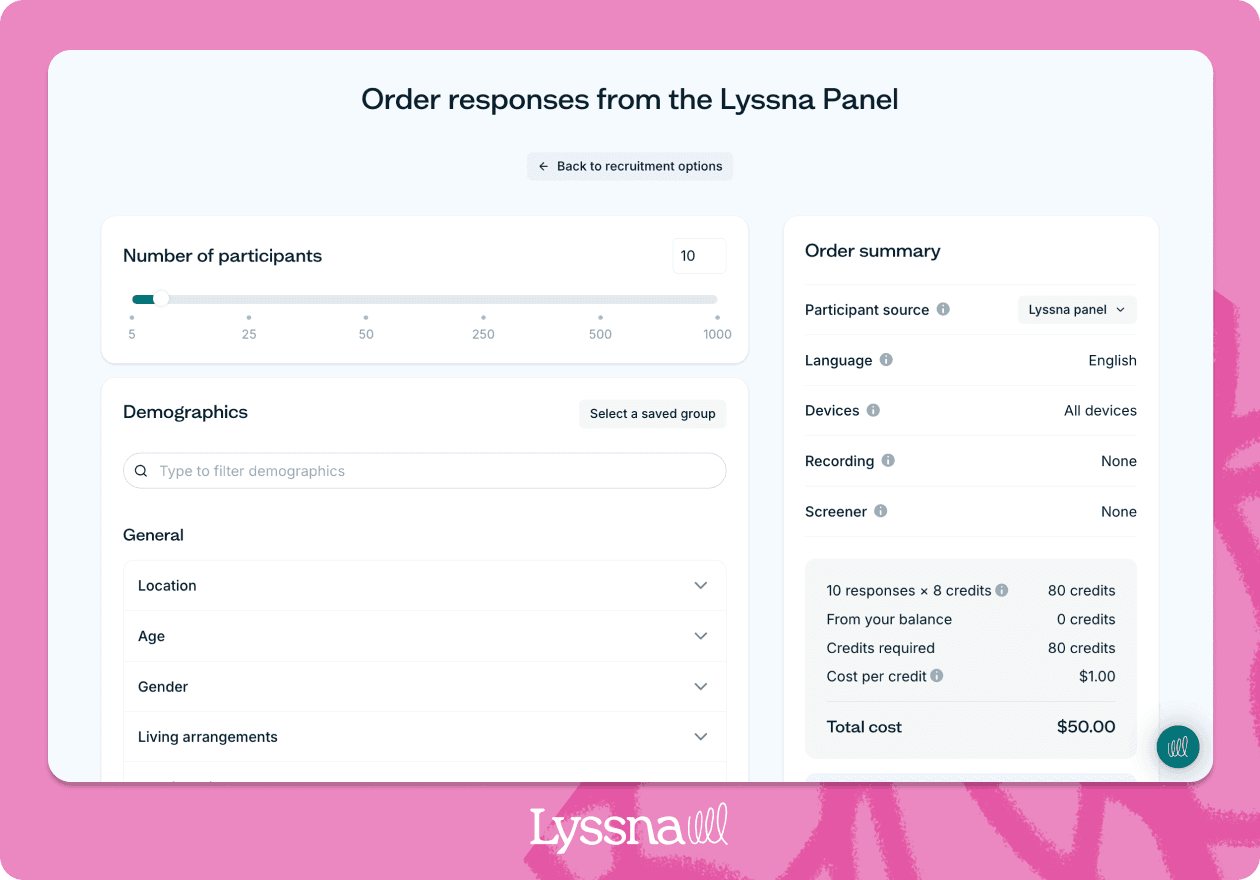
Whether you’re conducting moderated interviews, running unmoderated user tests, or recruiting using a research panel, Lyssna gives you the tools to uncover what drives your users. Turn raw data into clear, practical personas that guide better design decisions – all without the guesswork.
SurveyMonkey
SurveyMonkey offers user-friendly survey tools that help you collect quantitative data from your audience. Use it to design and distribute surveys that uncover user preferences, behaviors, and challenges, providing a solid foundation for your personas.
Semrush Persona Tool
Semrush includes a persona tool that uses market analytics and competitor research to build detailed marketing personas. It focuses on audience demographics, behaviors, and interests to guide marketing and product strategies.
Building personas: A guide to staying connected
Personas are more than profiles – they’re your bridge to understanding the people who rely on your work. They remind you that behind every click, every choice, and every interaction is a person with goals, frustrations, and dreams.
As behaviors change, markets shift, and new challenges arise, personas help you stay curious, adaptable, and focused on what matters most.
Pete Martin is a content writer for a host of B2B SaaS companies, as well as being a contributing writer for Scalerrs, a SaaS SEO agency. Away from the keyboard, he’s an avid reader (history, psychology, biography, and fiction), and a long-suffering Newcastle United fan.
Turn research into real personas
Ready to understand your users on a deeper level? Sign up to Lyssna today and start gathering the feedback to build personas that truly represent your audience.
FAQs
You may also like these articles


Try for free today
Join over 320,000+ marketers, designers, researchers, and product leaders who use Lyssna to make data-driven decisions.
No credit card required


